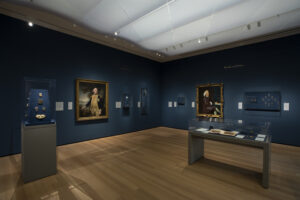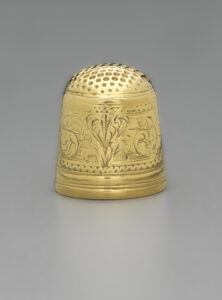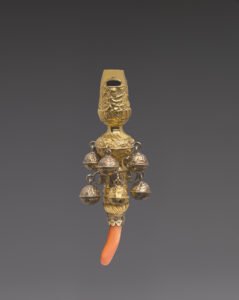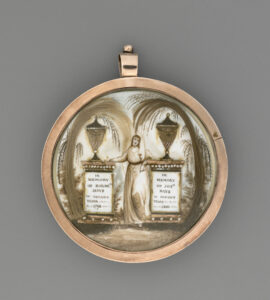Episode 159
What you’ll learn in this episode:
- Why we often have more information about gold than any other decorative object
- The difference between material culture and material studies, and how these fields shaped the study of art and jewelry
- What John wants visitors to take away from “Gold in America: Artistry, Memory and Power”
- Why history is much more global than we may think
- What it really means to curate, and why it’s an essential job
About John Stuart Gordon
John Stuart Gordon is the Benjamin Attmore Hewitt Curator of American Decorative Arts at the Yale University Art Gallery. He grew up among the redwoods of Northern California before venturing East and receiving a B.A. from Vassar College, an M.A. from the Bard Graduate Center for Studies in the Decorative Arts, Design, and Culture, and a PH.D. from Boston University. He works on all aspects of American design and has written on glass, American modernism, studio ceramics, and postmodernism. His exhibition projects have explored postwar American architecture, turned wood, and industrial design. In addition, he supervises the Furniture Study, the Gallery’s expansive study collection of American furniture and wooden objects.
Additional Resources:
- Yale University Art Gallery Website
- Yale University Art Gallery Instagram
- John Stuart Gordon Instagram
Photos:
[installation view] “Gold in America: Artistry, Memory, Power” is the first survey of American gold since 1963. It includes jewelry, housewares, presentation gifts, as well as coins, paintings, and photographs that illuminate the continued allure of gold over the centuries.

[thimble] Curator John Stuart Gordon hopes visitors will come away with a renewed curiosity for the gold they encounter in their lives. An object like this thimble–a rare survival made in Boston in the 1730s–are easy to overlook, but it documents the story of a young widow who became a successful merchant and was able to pass a gold thimble on to her daughters. Jacob Hurd, Thimble for Elizabeth Gooch Hubbart Franklin, Boston, 1730-40. Gold. Yale University Art Gallery, Mabel Brady Garvan Collection

Objects open up whole worlds when interpreted through the lens of material culture. Many children wore rattles or teething sticks around their necks, but few were made of gold and coral like this example. Made in New York in the 1760s its swirls, scrolls, and flowers are typical of the Rococo style. Its function speaks to social beliefs surrounding childhood, such as the use of coral that was believed to protect children. It was a gift from a grandmother to her granddaughter, a gift of love but also a way of passing wealth between women in the family. Daniel Christian Fueter, Whistle and Bells for Mary Duane North, New York, 1761–65. Gold and coral. Yale University Art Gallery, Mabel Brady Garvan Collection, Gift of Mrs. Francis P. Garvan, James R. Graham, Walter M. Jeffords, and Mrs. Paul Moore

Gold’s value and resistance to corrosion have made it a metaphor for the lasting nature of love and memory. This heart-breaking pendant uses gold, watercolor on ivory, and human hair to commemorate the deaths of two infant brothers. The weeping willows over the graves are made from locks of each boy’s hair while the figure in the center may be their mother. The economic value of gold is often rivaled by its sentimental value. Memorial for Solomon and Joseph Hays, probably New York, 1801. Watercolor, pearls, gold wire, beads, and hair (natural, chopped, and dissolved) on ivory. Yale University Art Gallery, Promised bequest of Davida Tenenbaum Deutsch and Alvin Deutsch in honor of Kathleen Luhrs

Transcript:
Perhaps more than any other metal or gem, gold brings out strong reactions in people (and has for all of recorded history). That’s what curator John Stuart Gordon wanted to explore with “Gold in America: Artistry, Memory, Power,” a featured exhibition now on view at the Yale University Art Gallery. He joined the Jewelry Journey Podcast to talk about why people have always been enchanted by gold; what he discovered while creating the exhibit; and why curation is more that just selecting a group of objects. Read the episode transcript here.
Sharon: Hello, everyone. Welcome to the Jewelry Journey Podcast. This is a two-part Jewelry Journey Podcast. Please make sure you subscribe so you can hear part two as soon as it comes out later this week.
Today, my guest is John Stuart Gordon, the Benjamin Attmore Hewitt Curator of American Decorative Arts at the Yale University Art Gallery. The Yale University Museum and Gallery is the oldest art museum in the western hemisphere associated with the university. John is going to be telling us today about one of the gallery’s current feature exhibitions, “Gold in America: Artistry, Memory, Power.” We’ll hear all about the exhibit and John’s journey today. John, welcome to the program.
John: Thank you. Thank you for having me. I apologize; my endowed title is a total mouthful.
Sharon: No, no. Who is Benjamin Attmore Hewitt?
John: Benjamin Attmore Hewitt was a clinical psychologist who helped bring the idea of statistical study to psychology, and he was also a collector. He was an avid collector of federal furniture, and he was associated with the art gallery. He, in the early 80s, was a guest curator on an exhibit on card tables that we did called “The Work of Many Hands.” In the incredibly small world department, I’m joining you from my living room, where if I turn and look out my window, I’m looking at the house that he used to live in across the street from me.
Sharon: Wow! Was that an old house that was built on federal plans or is it a modern house, the one he built or that that he has?
John: It is a beautiful, Georgian-style house. It’s quite gorgeous, and you can imagine it was perfect for his federal period collection.
Sharon: It sounds gorgeous.
John: It’s just one of those small-world things, right? I ended up moving across the street from person who endowed my job.
Sharon: Sounds gorgeous. So, tell us about your career path. Tell us how you ended up at the Yale University Art Gallery.
John: Yes, it was a dream job for me. I grew up in San Francisco. I grew up in a household that loved art, so I’m one of those lucky people that grew up from childhood thinking art isn’t scary; art isn’t strange; art is something to be enjoyed. I always knew I wanted to be in the art world somehow. I went to Vassar College in Poughkeepsie for the history of art program. When I graduated, I didn’t know what I wanted to do, but my first job was at Christie’s auction house, and that was an amazing experience. You see everything when you work in an auction house. It’s the fabulous things that get the headlines in the paper, but it’s everything else that gives you an education. That was an incredible training for my eye.
I’m a slow thinker. I like taking my time. I like spending time with objects. The constant hustle and bustle of the auction world was a little too much for me, so I went to grad school. I went to the Bard Graduate Center in New York and got my master’s. Then I had an internship at the Metropolitan Museum of Art. One of my colleagues there, the curator Amelia Peck, once said that if you would like a job at one of the great collections, you need a Ph.D. So, I said, “O.K.,” and I went to Boston University for a Ph.D. in American Studies.
The whole time I was thinking, “I want to get a Ph.D. so I can get a job at a place like the Yale University Art Gallery,” because its collection is legendary. It was the collection that so many of my professors used when they were teaching their survey courses. It was a collection I knew, and it was my aspirational job. One day while I was studying for my orals, my college professor called me and said, “A job has opened up at the Yale University Art Gallery. You need to apply for it.” Being a grad student, I was like, “Oh, I’m a little busy right now. Maybe next week,” and she was like, “John, don’t be stupid. These jobs don’t come up very often. You really need to apply.” I was very lucky. I got the job. That was 15 years ago, and I have been there ever since.
The collection is extraordinary. The museum was founded in 1832. It was one of the oldest museums in the country. Its American decorative arts collection formed very early on but really got going in 1930, so it’s also a very old collection. In the 1970s, one of the former curators, Charles Montgomery, felt it needed to go clear up to the present. So, our collection really spans centuries, and with that kind of span, you never get tired.
Sharon: It does. I was looking at your exhibit of gold online and I’m going, “Oh my god, this is going back.” I was looking at the gold collar you have and I thought, “This is really old.” What was that? The 3rd or 5th century or something like that? I can’t even remember.
John: The museum’s collections are encyclopedic. It goes from ancient Babylon up to the present day. Luckily, my slice of it is just the American, which is enough of a handful. There are two of us in our department, Patricia Kane and myself, and between the two of us, we need to cover pre-contact to the present in every medium. So, it’s enough to make your head spin some days.
Sharon: What is it about the decorative arts that attracted you as opposed to another area of history that you could also go into museums for?
John: That’s a great question. I loved the idea that decorative arts are like a lens into our world. Everything we make and own is a lens, but decorative arts have a way of telling you stories about the way we used the technology that went into making them, what a particular culture or a time period found important, as you make objects to fulfill needs and to fulfill aspirations. I loved the idea that you could take anything from a necklace or a teapot or a chair, and if you look at it enough ways, you could know a lot about the goals and dreams and technologies and resources of a given time period. I loved that idea, reverse-engineering culture through objects.
Sharon: That’s interesting, yes. How did the gold exhibit come about? Was that something you and Patricia had been thinking about, or was that a directive from on high? How did that come about?
John: The gold exhibition came about because of the pandemic, to be completely honest. Two years ago, the museum closed down, like many museums did at the beginning of the pandemic, and our exhibition calendar went out the window. Loans were cancelled, exhibitions were cancelled, and the director of the Yale University Art Gallery, Stephanie Wiles, put out a call for in-house exhibitions, exhibitions we could work on in our spare time. We didn’t know how long this was going to last. We thought we were going be home for a few weeks, and she wanted exhibitions that would be easy to slot into the calendar when the museum reopened and that would really shine a light on our collections, because those would be easier for the curators to research.
When I arrived at Yale in 2006, sitting on the shelf above my desk was a slim, little catalogue to an exhibition called “American Gold” that was done in 1963. I loved that little catalogue. I read it many times. I loved the material. Much of the material was drawn from Yale’s collections because Yale has one of the strongest collections of early American gold. I thought, “Someday, maybe I’ll revisit this.” It seemed amazing that no one had revisited this idea of gold since the 1960s because so much had changed about we think about the world, how we think about objects, what kind of theoretical models we use, and I thought I would do that exhibition at some point in the distant future. Then when our director said, “Are there are any ideas out there?” I said, “O.K., maybe I could do this now.” I suggested it, and it was a real treat. So, it was something that grew out of a spontaneous need but became a wonderful, wonderful research project.
Sharon: So, the objects for the most part are taken from your collection as opposed to loans, O.K. Tell us about the exhibit “Gold in America: Artistry, Memory, Power.” Tell us more about the whole exhibit. What do you want people to learn from it?
John: I was fascinated by the idea that gold is so compelling and so entrancing. There is something about this material that has been fascinating to humans for millennia. You think about the Egyptian pharaohs with their coffins covered in gold. Gold is the reason for so many wars and invasions, and all this is a sign of status. What is it about this material that has so much weight? I started talking to many of my colleagues, asking about the gold in their department, and we realized we could do a global show. It could be gigantic. It started getting away from me, and I realized, “O.K., let’s just focus on one very narrow portion of this global story. We’ll just focus on colonial American experience.”
As I started looking at those objects, I was struck by something rather uncanny. In the history of decorative arts, most objects are anonymous. We don’t know who made them. We don’t know who owned them. We don’t know how they traveled through time. With metalwork, we do tend to know a bit more because there are makers’ marks. There’s a whole history of guild systems that are looking at the purity of metals, and with gold we know even more information. I think probably more than almost any other material, we know who made gold objects and who owned them, and it’s because they often are inscribed or engraved somehow, or family histories come down with them. I found that so fascinating. That became the structure for the show, really thinking about these objects that have histories and why they were owned, why they were made, why they were cherished, thinking about this important material and how it intersects with human life over the span of a few centuries. That’s what I want visitors to take away.
Most people think—well, we can actually do this right now. Sharon and everyone listening, just to yourself, think of three words that come to mind immediately when I say gold. Free associate. What are those words that come to mind? Sharon, I’m going to put you on the spot. What three words come to mind?
Sharon: It’s like a blue elephant. What do I think? Shiny, valuable and decorative. In terms of jewelry, I think decorative. Those are the words that come to mind.
John: Shiny, valuable, decorative. I asked this question of a lot of people. Everyone I met for a while got that question, and value came up a lot. Then there were a lot of judgment terms, things like beauty or tacky. They were either positive or negative terms. People have an emotional, visceral reaction to gold. What I want people who visit the show to do is to move beyond those initial associations. We’re drawn to it because it’s valuable and we think it’s beautiful, or we’re skeptical of it because we think it might be gaudy. But I want them to really look at the objects and learn why someone might own something or why someone might want an object made out of this material. It’s to move beyond those initial words into words about legacy and heritage or patriotism or pride, to get to that second layer. It’s to let people know O.K., I’m going to think twice about what a gold ring might symbolize because I’ve looked at a gold ring that was all about mourning and commemorating the dead, or I’ve looked at something like a gold spoon that seemed a little flashy, but we know it was made by a Huguenot craftsman escaping religious persecution in New York, yet it was owned by someone who made their money selling slaves. Ideas of freedom and persecution are wrapped up in this material. There are so many stories that, once you start asking the objects, the stories come back to you in a way that I hope makes people pause when they leave the museum and see something else in their life. “Oh, that’s an interesting idea.”
Sharon: I think what strikes me is the fact that when you’re talking about gold, artistry, memory and power over the years, the wars that have been fought, I think of the Aztecs and Incas, where it was so cherished. We talked a little about this. Material culture, material studies. You’ll have to explain the difference. That sounds like something I didn’t grow up hearing. Maybe because you’re in that world, it’s something you’ve heard about for a long time. But what is material culture and material studies, and how does it relate to this?
John: That is such a big question. I’ll try to do some honor to it. The idea of material culture as an academic field—and I’m sorry; I have to put on my dorky academic for a second—but the idea of material culture really came out in the 1960s and 1970s with this larger idea of a new history, a way of looking at the reinterpretation of historical sources, historical stories, questioning who has the right to tell history. It was a way to get away from just looking at the histories of wars and rulers, documenting dead white men written by more dead white men. Material culture is a way of looking holistically at the objects that are produced by a civilization and thinking about the everyday person or the person not on the throne. What can be learned from the things that are not just the dates of rules and wars? That field really transformed art history, history, American studies, anthropology, archaeology. It opened up various fields of study so that you could write an entire book about the development of the Coke bottle and have a valid historical discussion about everyday objects.
What’s been fascinating—I grew up in this world. To me, material culture is my language. I grew up being taught by people who were on the front wave of this, so I’m totally indoctrinated. In recent years, I’ve seen a subfield emerge just called material studies. It makes chuckle a bit because it’s like material culture with the culture taken out, which is probably not true, but it’s really just going into the actual “thinginess” of objects: thinking about the marble that a statue was carved from, or thinking about the wood used to make a chair and diving deep into this elemental level of what the material of our world is, where it comes from and what stories it tells.
In terms of gold, your mentioning the Incas is, I think, a rather important reference, because where was the gold coming from? If we take an Inca material studies approach to this, we think about how, for many years, the Mediterranean in Europe, they weren’t reusing and melting down and recycling the gold that was coming out of a very limited number of mines. Then suddenly, the Spanish discover or stumble across the New World, and they see these cities with temples filled with gold and palaces filled with gold, and they start looting them. As the conquistadors are conquering Central and South America, they’re stripping the gold out, and then that gold is being melted down and being sent back to Europe. What does it mean to have this material that’s so inherently fraught with conflict?
What does it mean for a silversmith in Boston in the 18th century? He’s sitting on the edge of an empire working a small amount of gold that’s incredibly valuable because he has to get it from London. He’s aware that the Spanish have all this access to gold through the New World, and it’s circulating around him. Then how does all of this change when gold is discovered at Sutter’s Mill in California in 1849, and suddenly there’s a whole new and incredibly large source of gold? It’s augmented by further strikes in Colorado, and the West begins creating more gold. Think about this material, how its rarity is tied to conquest and imperial control.
There are some scientists who have been thinking, “Can we do tests on material to find out if there are little isotopes in the metal that can tell you whether the ring you’re wearing today is gold that was from Northern California or from Afghanistan? Can we begin to map out the world and map out trade routes all based on scientific inquiry and matching scientific testing with archival research?” Your very quick dive into material culture versus material studies, it’s endlessly fascinating.
Sharon: I know people get their doctorates in material studies around things like that. I should have asked you this at the beginning. Did you consider yourself an artist when you grew up with all this art? Before art history, were you creative? Were your parents in the creative end of the arts or were they teaching?
John: Being an artist was option number one, and I pursued that. Making art was a really important part of my childhood and developing a sense of identity. Then I learned about art history. I just loved art history, and I had to make that decision: would I go to art school or would I go to a liberal arts college? For me, art history won. I loved being able to parse out these stories and to look at objects and paintings and sculptures and think about all the different references. But having that history of making, I think, is very important. I have a lot of empathy for the skill and the creativity that goes into making.

